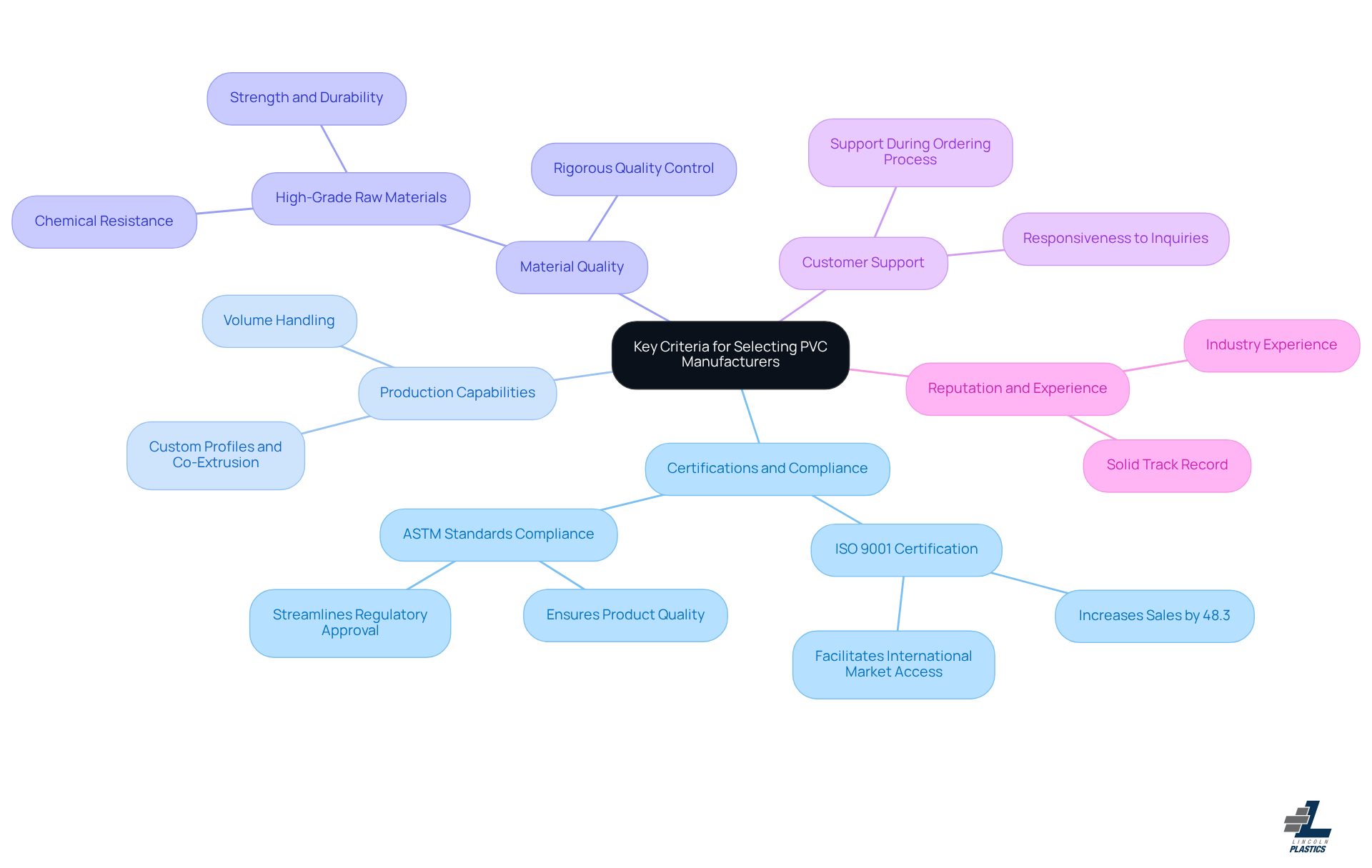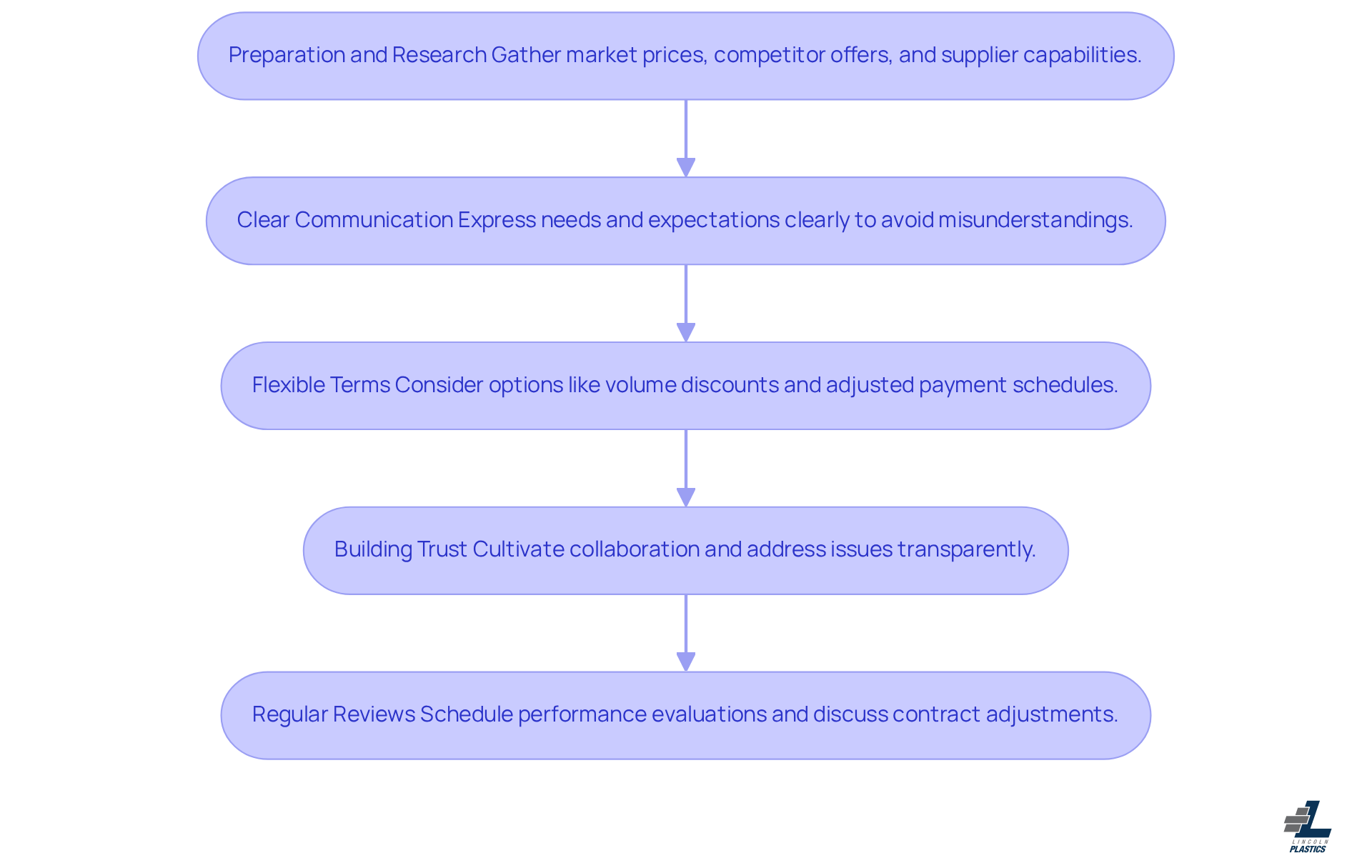
Master PVC Manufacturers: A Step-by-Step Guide for OEM Managers
Introduction
Navigating the world of Polyvinyl Chloride (PVC) can feel a bit overwhelming for OEM managers, right? This versatile thermoplastic polymer comes in all sorts of forms, each designed for specific uses - from construction to medical devices. So, how do you pick the right PVC manufacturers?
In this guide, we’ll dive into the key aspects of selecting the best partners, evaluating their capabilities, and building strong supplier relationships. These elements can really make a difference in product quality and operational efficiency. But with so many options out there, you might be wondering: how can you ensure you’re choosing the right partners to meet your unique needs and standards? Let’s explore this together!
Understand PVC: Types and Properties
Polyvinyl Chloride (PVC) is quite the versatile thermoplastic polymer, and it’s used in a ton of different applications. You’ll mainly find it in two forms: rigid PVC (uPVC) and flexible PVC (pPVC). Rigid PVC is known for its strength and durability, making it a go-to for construction projects, especially when it comes to pipes and fittings. On the flip side, flexible PVC has plasticizers that make it more pliable, which is perfect for things like electrical cables and medical devices. Understanding these properties is super important for OEM managers who want to select the right type from PVC manufacturers for their needs, ensuring their products perform well and last longer.
Now, let’s talk about some key properties of PVC:
- Durability: PVC is tough! It resists corrosion and impact, making it a solid choice for long-term use.
- Chemical Resistance: It can handle exposure to various chemicals, which is crucial for industrial applications where reliability is key.
- Lightweight: Compared to many alternatives, PVC is lighter, helping to cut down on shipping costs and making it easier to handle.
- Cost-Effectiveness: PVC is affordable, which is why so many producers love it. It allows for competitive pricing across different markets.
Recent studies show that rigid PVC really shines in applications where structural integrity is a must, while flexible PVC is the star when adaptability is needed. For example, in agriculture, switching from metal to PVC piping has boosted efficiency and slashed maintenance costs-talk about a win! And let’s not forget flexible PVC in medical devices; it’s crucial in industries where flexibility and safety are top priorities.
By getting a grip on these characteristics and uses, OEM managers can make smart choices about which type of PVC manufacturers will best meet their manufacturing needs. This ultimately leads to better product standards and performance. So, what do you think? Ready to dive into the world of PVC and see how it can work for you?

Identify Key Criteria for Selecting PVC Manufacturers
When you're on the hunt for a PVC manufacturer, there are a few key things you really want to keep in mind:
-
Certifications and Compliance:
- First off, check if the manufacturer has the right certifications. ISO 9001 is a big one - it shows they stick to strict quality management standards. This isn’t just about reliability; it also opens doors to international markets. So, it’s definitely something OEMs should prioritize.
-
Production Capabilities:
- Next, think about their production capabilities. Can they handle the volume and complexity of what you need? Look for their ability to create custom profiles and use co-extrusion techniques. These can really boost the functionality and performance of your products.
-
Material Quality:
- Now, let’s talk about the materials. You’ll want to dig into the quality of the raw materials they use, especially the type of PVC resin and additives. High-quality materials are crucial for durability, chemical resistance, and overall performance.
-
Customer Support:
- Don’t overlook customer support! How responsive are they to your inquiries? What kind of support do they offer during the ordering process? Good customer service can make a huge difference in how smoothly your project runs.
-
Reputation and Experience:
- Finally, do a little research on the manufacturer’s history and experience. Companies with a solid track record are often more reliable partners, ensuring you get those mission-critical components on time.
By keeping these criteria in mind, you can streamline your selection process and team up with PVC manufacturers that really align with your operational goals and standards. So, what do you think? Ready to find the right partner?

Evaluate Manufacturer Capabilities and Reliability
To effectively evaluate the capabilities and reliability of PVC manufacturers, OEM managers should follow these steps:
-
Site Visits:
Now, let’s talk about site visits. It’s crucial to conduct on-site visits to really get a feel for the manufacturing processes, equipment, and overall facility conditions. Direct observation can uncover essential insights into operational standards and compliance with excellence practices. -
Performance Metrics:
You might be wondering about performance metrics. Requesting data on key performance indicators (KPIs) like production efficiency, defect rates, and delivery times is a smart move. For instance, PVC manufacturers may experience varying defect rates, with some plants reporting daily defect rates between 10% and 15%. Keeping an eye on these metrics is essential for gauging reliability and operational effectiveness. -
References and Reviews:
Next up, let’s discuss references and reviews. Seeking references from other clients and reading reviews can give you a clearer picture of the manufacturer's reputation in the industry. Positive feedback from current clients often reflects a producer's dependability and dedication to excellence. -
Trial Orders:
How about trial orders? Placing small trial orders is a great way to evaluate product quality and the manufacturer's responsiveness. This step allows managers to assess the consistency of standards and service before diving into larger contracts. -
Quality Control Processes:
Finally, inquire about the manufacturer's quality control measures. Ask about testing protocols and compliance with industry standards. Robust quality control can significantly reduce defect rates, with effective methodologies leading to reductions of up to 9% in defects over a short period.
By implementing these evaluation techniques, OEM managers can ensure they choose PVC manufacturers capable of consistently delivering high-quality products. This not only enhances their operational efficiency but also boosts reliability.

Negotiate Contracts and Manage Supplier Relationships
Negotiating contracts and managing supplier relationships can feel a bit daunting, right? But don’t worry! Here are some key strategies to help you navigate this process smoothly:
-
Preparation and Research:
- Start by gathering all the juicy details on market prices, what your competitors are offering, and what your supplier can bring to the table. This foundational knowledge not only boosts your confidence but also helps you spot areas where you can collaborate.
-
Clear Communication:
- When you’re in negotiations, make sure to clearly express your needs and expectations. Good communication is key to avoiding misunderstandings and building strong partnerships. Did you know that a recent survey found 54% of business leaders consider transparency the most important quality in vendor relationships? That just shows how vital open dialogue is!
-
Flexible Terms:
- Keep an open mind about flexible contract terms that could benefit both sides. Think about options like volume discounts or adjusted payment schedules. These can create win-win situations that boost vendor loyalty and performance. Plus, reviewing discounts every 6-12 months can lead to some serious savings and strengthen your partnership.
-
Building Trust:
- It’s all about cultivating a collaborative vibe with your suppliers. Keep those communication lines open! Addressing issues quickly and transparently helps build trust, which is crucial for long-term success. Remember, if vendors feel unappreciated, they might not stick around. Acknowledgment goes a long way! Procurement experts say that strong partnerships with providers are essential for growth in today’s competitive market.
-
Regular Reviews:
- Don’t forget to schedule regular performance reviews! These check-ins are perfect for evaluating how your supplier is doing and discussing any necessary contract tweaks. Regular assessments not only ensure compliance but also open the door for continuous improvement and innovation. Plus, having real-time insights into vendor performance helps you tackle challenges quickly, further solidifying your relationship.
By putting these strategies into action, OEM managers can negotiate contracts that work in their favor while building strong, productive relationships with their PVC manufacturers. This ultimately drives operational efficiency and leads to mutual success. So, what are you waiting for? Let’s get started!

Conclusion
Understanding the different uses and properties of PVC is super important for OEM managers who want to optimize their manufacturing processes. When you get the hang of rigid and flexible PVC, you can make smarter choices that boost product quality and longevity. This knowledge not only helps you pick the right materials but also supports the creation of products that meet tough industry standards.
Now, let’s talk about why it’s crucial to choose the right PVC manufacturers. Look for things like:
- Certifications
- Production capabilities
- Material quality
- Customer support
- Reputation
Plus, taking the time to visit manufacturers, check performance metrics, and place trial orders can really help you find reliable suppliers who consistently deliver high-quality products. These steps are key to building strong partnerships.
Ultimately, mastering PVC manufacturing isn’t just about understanding the material. It’s also about negotiating contracts and building solid relationships with suppliers. By keeping communication clear, being flexible with terms, and doing regular performance reviews, you can create partnerships that enhance operational efficiency and lead to mutual success. Embracing these practices will not only raise product standards but also help your business thrive in the competitive PVC manufacturing landscape.
Frequently Asked Questions
What are the two main forms of PVC?
The two main forms of PVC are rigid PVC (uPVC) and flexible PVC (pPVC).
What are the characteristics of rigid PVC?
Rigid PVC is known for its strength and durability, making it ideal for construction projects, particularly for pipes and fittings.
What makes flexible PVC different from rigid PVC?
Flexible PVC contains plasticizers that make it more pliable, making it suitable for applications like electrical cables and medical devices.
Why is understanding the properties of PVC important for OEM managers?
Understanding PVC properties helps OEM managers select the right type from manufacturers, ensuring their products perform well and last longer.
What are some key properties of PVC?
Key properties of PVC include durability, chemical resistance, lightweight nature, and cost-effectiveness.
How does PVC's durability benefit its applications?
PVC's durability allows it to resist corrosion and impact, making it a solid choice for long-term use in various applications.
In what way does PVC's chemical resistance benefit industrial applications?
PVC's chemical resistance allows it to handle exposure to various chemicals, which is crucial for reliability in industrial settings.
Why is the lightweight nature of PVC advantageous?
Being lightweight helps reduce shipping costs and makes PVC easier to handle compared to many alternatives.
How does the cost-effectiveness of PVC impact its popularity?
PVC's affordability makes it a popular choice among producers, allowing for competitive pricing across different markets.
Can you give examples of where rigid and flexible PVC excel?
Rigid PVC excels in applications requiring structural integrity, while flexible PVC is preferred in situations needing adaptability, such as in agriculture and medical devices.
List of Sources
- Understand PVC: Types and Properties
- Polyvinyl Chloride (PVC) Production Cost Analysis 2025: Equipment, Raw Materials and Investment Overview (https://openpr.com/news/4092543/polyvinyl-chloride-pvc-production-cost-analysis-2025)
- Topic: Polyvinyl chloride (PVC) (https://statista.com/topics/11401/polyvinyl-chloride-pvc?srsltid=AfmBOoqi_7IyC1EWAaDStSJIy6PrGX4ybxOdYAcYxY9_rP1cqfvr6d2S)
- Trends of New PVC Products: 2025 Innovations & Market Forecasts (https://accio.com/business/trend-of-new-pvc-products)
- Plastic pipe demand growing due to its ‘critical roles' (https://plasticsnews.com/news/us-plastic-pipe-market-hit-268b-2028-amid-infrastructure-surge)
- Polyvinyl Chloride Market Size | PVC Industry Share, 2030 (https://fortunebusinessinsights.com/polyvinyl-chloride-pvc-market-109398)
- Identify Key Criteria for Selecting PVC Manufacturers
- 47% of sales linked to ISO 9001 certification - Business Benefits (https://business-benefits.org/case-study/47-sales-linked-iso-9001-certification)
- New research shows ISO 9001:2015 Certification boosts business performance (https://scc-ccn.ca/resources/news/new-research-shows-iso-90012015-certification-boosts-business-performance)
- What to Look for in a PVC Pipe Manufacturer Quality Range and Compliance (https://lessoamerica.com/news/industry-news/723.html)
- CHEMICALS H2 2025: PVC makers rethink trade flows amid excess capacity, regulatory changes (https://spglobal.com/commodity-insights/en/news-research/latest-news/chemicals/072925-chemicals-h2-2025-pvc-makers-rethink-trade-flows-amid-excess-capacity-regulatory-changes)
- ISO Survey 2022 - ISO 9001 and ISO 14001 Certifications Around the World - simpleQuE (https://simpleque.com/iso-survey-2022-iso-9001-and-iso-14001-certifications-around-the-world)
- Evaluate Manufacturer Capabilities and Reliability
- Top 100 Supply Chain Management Quotes [2025] (https://digitaldefynd.com/IQ/motivational-supply-chain-management-quotes)
- Improvement of quality performance in manufacturing organizations by minimization of production defects (https://sciencedirect.com/science/article/abs/pii/S0736584506000664)
- Viewpoint: PVC expansions loom over US market in 2025 | Latest Market News (https://argusmedia.com/en/news-and-insights/latest-market-news/2642451-viewpoint-pvc-expansions-loom-over-us-market-in-2025)
- What are core 5 KPIs of Pvc Pipe Manufacturing Business? (https://startupfinancialprojection.com/blogs/kpis/pvc-pipe-manufacturing)
- KPI's for Production Engineer in PVC Pipe Manufacturing (https://linkedin.com/pulse/kpis-production-engineer-pvc-pipe-manufacturing-dewan-md-maniruzzaman)
- Negotiate Contracts and Manage Supplier Relationships
- Inflation: Negotiate with suppliers and don't panic (https://supplychaindive.com/news/supplier-negotiations-procurement-inflation/605380)
- Buyer Supplier Relationship Management: The Key to Resilient and Efficient Supply Chains (https://liferay.com/blog/business-partner-experience/-buyer-supplier-relationship-management)
- 4 Tips for More Effective Supplier Contract Negotiations (https://raiven.com/blog/4-tips-for-more-effective-supplier-contract-negotiations)
- Supplier Engagement & Communication Needs Renewed Focus (https://hicx.com/blog/supplier-engagement-communication-needs-focus)
- Supplier Relationship Management: Strategies & Best Practices (https://jpmorgan.com/insights/business-planning/supplier-relationship-management-strategies-and-best-practices)


